Metabolomics Combined with Sensory Analysis Reveals the Impact of Different Extraction Methods on Coffee Beverages from Coffea arabica and Coffea canephora var. Robusta
Abstract
:1. Introduction
2. Materials and Methods
2.1. Coffee Samples
2.2. Extraction Methods
2.3. Sensory Analysis
2.4. Extraction of Metabolites from Coffee Samples
2.5. Untargeted Metabolomic Profiling through UHPLC-QTOF Mass Spectrometry
2.6. Multivariate Statistical Analysis
2.6.1. Metabolomic Data
2.6.2. Sensory Data
3. Results and Discussion
3.1. Untargeted Profiling by UHPLC-QTOF-Mass Spectrometry
3.2. Multivariate Statistical Discrimination of the Different Extraction Methods
3.3. Sensory Analysis
4. Conclusions
Supplementary Materials
Author Contributions
Funding
Institutional Review Board Statement
Informed Consent Statement
Data Availability Statement
Acknowledgments
Conflicts of Interest
References
- Ico.Org. Available online: http://www.ico.org/prices/po-production.pdf (accessed on 15 February 2021).
- Scalabrin, S.; Toniutti, L.; Di Gaspero, G.; Scaglione, D.; Magris, G.; Vidotto, M.; Pinosio, S.; Cattonaro, F.; Magni, F.; Jurman, I.; et al. A Single Polyploidization Event at the Origin of the Tetraploid Genome of Coffea Arabica Is Responsible for the Extremely Low Genetic Variation in Wild and Cultivated Germplasm. Sci. Rep. 2020, 10, 4642. [Google Scholar] [CrossRef] [PubMed] [Green Version]
- Illy, A.; Viani, R. Espresso Coffee: The Science of Quality; Academic Press: Cambridge, MA, USA, 2005; ISBN 9780123703712. [Google Scholar]
- Privat, I.; Foucrier, S.; Prins, A.; Epalle, T.; Eychenne, M.; Kandalaft, L.; Caillet, V.; Lin, C.; Tanksley, S.; Foyer, C.; et al. Differential Regulation of Grain Sucrose Accumulation and Metabolism in Coffea Arabica (Arabica) and Coffea Canephora (Robusta) Revealed through Gene Expression and Enzyme Activity Analysis. New Phytol. 2008, 178, 781–797. [Google Scholar] [CrossRef]
- Cenci, A.; Combes, M.-C.; Lashermes, P. Genome Evolution in Diploid and Tetraploid Coffea Species as Revealed by Comparative Analysis of Orthologous Genome Segments. Plant Mol. Biol. 2012, 78, 135–145. [Google Scholar] [CrossRef]
- Ne Perrois, C.; Strickler, S.R.; Mathieu, G.; Lepelley, M.; Bedon, L.; Michaux, S.; Husson, J.; Mueller, L.; Privat, I. Differential Regulation of Caffeine Metabolism in Coffea Arabica (Arabica) and Coffea Canephora (Robusta). Plants 2015, 241, 179–191. [Google Scholar] [CrossRef] [PubMed] [Green Version]
- Koshiro, Y.; Jackson, M.C.; Katahira, R.; Wang, M.L.; Nagai, C.; Ashihara, H. Biosynthesis of Chlorogenic Acids in Growing and Ripening Fruits of Coffea Arabica and Coffea Canephora Plants. Z. Fur Nat.-Sect. C J. Biosci. 2007, 62, 731–742. [Google Scholar] [CrossRef] [PubMed]
- Maeztu, L.; Sanz, C.; Andueza, S.; Paz De Peña, M.; Bello, J.; Cid, C. Characterization of Espresso Coffee Aroma by Static Headspace GC-MS and Sensory Flavor Profile. J. Agric. Food Chem. 2001, 49, 5437–5444. [Google Scholar] [CrossRef]
- Caprioli, G.; Cortese, M.; Sagratini, G.; Vittori, S. The Influence of Different Types of Preparation (Espresso and Brew) on Coffee Aroma and Main Bioactive Constituents. Int. J. Food Sci. Nutr. 2015, 66, 505–513. [Google Scholar] [CrossRef]
- Gloess, A.N.; Vietri, A.; Wieland, F.; Smrke, S.; Schönbächler, B.; López, J.A.S.; Petrozzi, S.; Bongers, S.; Koziorowski, T.; Yeretzian, C. Evidence of Different Flavour Formation Dynamics by Roasting Coffee from Different Origins: On-Line Analysis with PTR-ToF-MS. Int. J. Mass Spectrom. 2014, 365, 324–337. [Google Scholar] [CrossRef] [Green Version]
- Gloess, A.N.; Schönbächler, B.; Klopprogge, B.; Chatelain, K.; Bongartz, A.; Strittmatter, A.; Rast, M.; Yeretzian, C. Comparison of Nine Common Coffee Extraction Methods: Instrumental and Sensory Analysis. Eur. Food Res. Technol. 2013, 236, 607–627. [Google Scholar] [CrossRef] [Green Version]
- Rocchetti, G.; Braceschi, G.P.; Odello, L.; Bertuzzi, T.; Trevisan, M.; Lucini, L. Identification of Markers of Sensory Quality in Ground Coffee: An Untargeted Metabolomics Approach. Metab. Off. J. Metab. Soc. 2020, 16, 127. [Google Scholar] [CrossRef]
- Koh, G.H.; Lee, C.H.; Yoon, J. Physicochemical Characteristics of Coffee Brews Using Different Brewing Methods. Food Eng. Prog. 2020, 24, 110–119. [Google Scholar] [CrossRef]
- Xu, L.; Lao, F.; Xu, Z.; Wang, X.; Chen, F.; Liao, X.; Chen, A.; Yang, S. Use of Liquid Chromatography Quadrupole Time-of-Flight Mass Spectrometry and Metabolomic Approach to Discriminate Coffee Brewed by Different Methods. Food Chem. 2019, 286, 106–112. [Google Scholar] [CrossRef] [PubMed]
- The Italian Market Potential for Coffee CBI. Available online: https://www.cbi.eu/market-information/coffee/italy/market-potential (accessed on 3 December 2021).
- Cordoba, N.; Fernandez-Alduenda, M.; Moreno, F.L.; Ruiz, Y. Coffee Extraction: A Review of Parameters and Their Influence on the Physicochemical Characteristics and Flavour of Coffee Brews. Trends Food Sci. Technol. 2020, 96, 45–60. [Google Scholar] [CrossRef]
- Caporaso, N.; Genovese, A.; Canela, M.D.; Civitella, A.; Sacchi, R. Neapolitan Coffee Brew Chemical Analysis in Comparison to Espresso, Moka and American Brews. Food Res. Int. 2014, 61, 152–160. [Google Scholar] [CrossRef]
- Wei, F.; Furihata, K.; Miyakawa, T.; Tanokura, M. A Pilot Study of NMR-Based Sensory Prediction of Roasted Coffee Bean Extracts. Food Chem. 2014, 152, 363–369. [Google Scholar] [CrossRef] [PubMed]
- Hutachok, N.; Koonyosying, P.; Pankasemsuk, T.; Angkasith, P.; Chumpun, C.; Fucharoen, S.; Srichairatanakool, S. Chemical Analysis, Toxicity Study, and Free-Radical Scavenging and Iron-Binding Assays Involving Coffee (Coffea arabica) Extracts. Molecules 2021, 26, 4169. [Google Scholar] [CrossRef] [PubMed]
- Leroy, T.; de Bellis, F.; Legnate, H.; Kananura, E.; Gonzales, G.; Pereira, L.F.; Andrade, A.C.; Charmetant, P.; Montagnon, C.; Cubry, P.; et al. Improving the Quality of African Robustas: QTLs for Yield- and Quality-Related Traits in Coffea Canephora. Tree Genet. Genomes 2011, 7, 781–798. [Google Scholar] [CrossRef] [Green Version]
- Gamboa-Becerra, R.; Hernández-Hernández, M.C.; González-Ríos, Ó.; Suárez-Quiroz, M.L.; Gálvez-Ponce, E.; Ordaz-Ortiz, J.J.; Winkler, R. Metabolomic Markers for the Early Selection of Coffea Canephora Plants with Desirable Cup Quality Traits. Metabolites 2019, 9, 214. [Google Scholar] [CrossRef] [Green Version]
- Navarini, L.; Nobile, E.; Pinto, F.; Scheri, A.; Suggi-Liverani, F. Experimental Investigation of Steam Pressure Coffee Extraction in a Stove-Top Coffee Maker. Appl. Therm. Eng. 2008, 29, 998–1004. [Google Scholar] [CrossRef] [Green Version]
- Wellinger, A.-M.; Smrke, S.; Yeretzian, C. The Scae Water Chart Measure Aim Treat; Zurich University of Applied Sciences: Winterthur, Switzerland, 2016. [Google Scholar]
- World Coffee Research SENSORY LEXICON Unabridged Definition and References Version 2.0. Available online: https://worldcoffeeresearch.org/resources/sensory-lexicon (accessed on 1 February 2022).
- Salek, R.M.; Steinbeck, C.; Viant, M.R.; Goodacre, R.; Dunn, W.B. The Role of Reporting Standards for Metabolite Annotation and Identification in Metabolomic Studies. GigaScience 2013, 2, 13. [Google Scholar] [CrossRef]
- Tsugawa, H.; Kind, T.; Nakabayashi, R.; Yukihira, D.; Tanaka, W.; Cajka, T.; Saito, K.; Fiehn, O.; Arita, M. Hydrogen Rearrangement Rules: Computational MS/MS Fragmentation and Structure Elucidation Using MS-FINDER Software. Anal. Chem. 2016, 88, 7946–7958. [Google Scholar] [CrossRef] [PubMed]
- Senizza, A.; Rocchetti, G.; Callegari, M.L.; Lucini, L.; Morelli, L. Linoleic Acid Induces Metabolic Stress in the Intestinal Microorganism Bifidobacterium Breve DSM 20213. Sci. Rep. 2020, 10, 5997. [Google Scholar] [CrossRef]
- Portela, C.D.S.; de Almeida, I.F.; Mori, A.L.B.; Yamashita, F.; Benassi, M.D.T. Brewing Conditions Impact on the Composition and Characteristics of Cold Brew Arabica and Robusta Coffee Beverages. LWT 2021, 143, 111090. [Google Scholar] [CrossRef]
- Asamenew, G.; Kim, H.W.; Lee, M.K.; Lee, S.H.; Lee, S.; Cha, Y.S.; Lee, S.H.; Yoo, S.M.; Kim, J.B. Comprehensive Characterization of Hydroxycinnamoyl Derivatives in Green and Roasted Coffee Beans: A New Group of Methyl Hydroxycinnamoyl Quinate. Food Chem. X 2019, 2, 100033. [Google Scholar] [CrossRef] [PubMed]
- Berti, F.; Navarini, L.; Colomban, S.; Forzato, C. Hydroxycinnamoyl Amino Acids Conjugates: A Chiral Pool to Distinguish Commercially Exploited Coffea spp. Molecules 2020, 25, 1704. [Google Scholar] [CrossRef] [Green Version]
- Frew, A.; Powell, J.R.; Glauser, G.; Bennett, A.E.; Johnson, S.N. Mycorrhizal Fungi Enhance Nutrient Uptake but Disarm Defences in Plant Roots, Promoting Plant-Parasitic Nematode Populations. Soil Biol. Biochem. 2018, 126, 123–132. [Google Scholar] [CrossRef]
- Lucini, L.; Rocchetti, G.; Trevisan, M. Extending the Concept of Terroir from Grapes to Other Agricultural Commodities: An Overview. Curr. Opin. Food Sci. 2020, 31, 88–95. [Google Scholar] [CrossRef]
- Balzano, M.; Loizzo, M.R.; Tundis, R.; Lucci, P.; Nunez, O.; Fiorini, D.; Giardinieri, A.; Frega, N.G.; Pacetti, D. Spent Espresso Coffee Grounds as a Source of Anti-Proliferative and Antioxidant Compounds. Innov. Food Sci. Emerg. Technol. 2020, 59, 102254. [Google Scholar] [CrossRef]
- Daglia, M.; Papetti, A.; Aceti, C.; Sordelli, B.; Spini, V.; Gazzani, G. Isolation and Determination of Alpha-Dicarbonyl Compounds by RP-HPLC-DAD in Green and Roasted Coffee. J. Agric. Food Chem. 2007, 55, 8877–8882. [Google Scholar] [CrossRef]
- Caporaso, N.; Whitworth, M.B.; Cui, C.; Fisk, I.D. Variability of Single Bean Coffee Volatile Compounds of Arabica and Robusta Roasted Coffees Analysed by SPME-GC-MS. Food Res. Int. 2018, 108, 628–640. [Google Scholar] [CrossRef]
- Becalski, A.; Hayward, S.; Krakalovich, T.; Pelletier, L.; Roscoe, V.; Vavasour, E. Development of an Analytical Method and Survey of Foods for Furan, 2-Methylfuran and 3-Methylfuran with Estimated Exposure. Food Addit. Contam. Part A Chem. Anal. Control. Expo. Risk Assess. 2010, 27, 764–775. [Google Scholar] [CrossRef] [PubMed]
- Limacher, A.; Kerler, J.; Davidek, T.; Schmalzried, F.; Blank, I. Formation of Furan and Methylfuran by Maillard-Type Reactions in Model Systems and Food. J. Agric. Food Chem. 2008, 56, 3639–3647. [Google Scholar] [CrossRef]
- Rahn, A.; Yeretzian, C. Impact of Consumer Behavior on Furan and Furan-Derivative Exposure during Coffee Consumption. A Comparison between Brewing Methods and Drinking Preferences. Food Chem. 2019, 272, 514–522. [Google Scholar] [CrossRef] [PubMed]
- Budryn, G.; Nebesny, E.; Oracz, J. Correlation Between the Stability of Chlorogenic Acids, Antioxidant Activity and Acrylamide Content in Coffee Beans Roasted in Different Conditions. Int. J. Food Prop. 2015, 18, 290–302. [Google Scholar] [CrossRef]
- Lolli, V.; Acharjee, A.; Angelino, D.; Tassotti, M.; Del Rio, D.; Mena, P.; Caligiani, A. Chemical Characterization of Capsule-Brewed Espresso Coffee Aroma from the Most Widespread Italian Brands by HS-SPME/GC-MS. Molecules 2020, 25, 1166. [Google Scholar] [CrossRef] [PubMed] [Green Version]
- Hyong, S.; Chu, M.; Park, H.; Park, J.; Lee, K.G. Analysis of α-Dicarbonyl Compounds and 4-Methylimidazole in Coffee Made with Various Roasting and Brewing Conditions. LWT 2021, 151, 112231. [Google Scholar] [CrossRef]
- Yaylayan, V.A.; Haffenden, L.J.W. Mechanism of Imidazole and Oxazole Formation in [13C-2]-Labelled Glycine and Alanine Model Systems. Food Chem. 2003, 81, 403–409. [Google Scholar] [CrossRef]
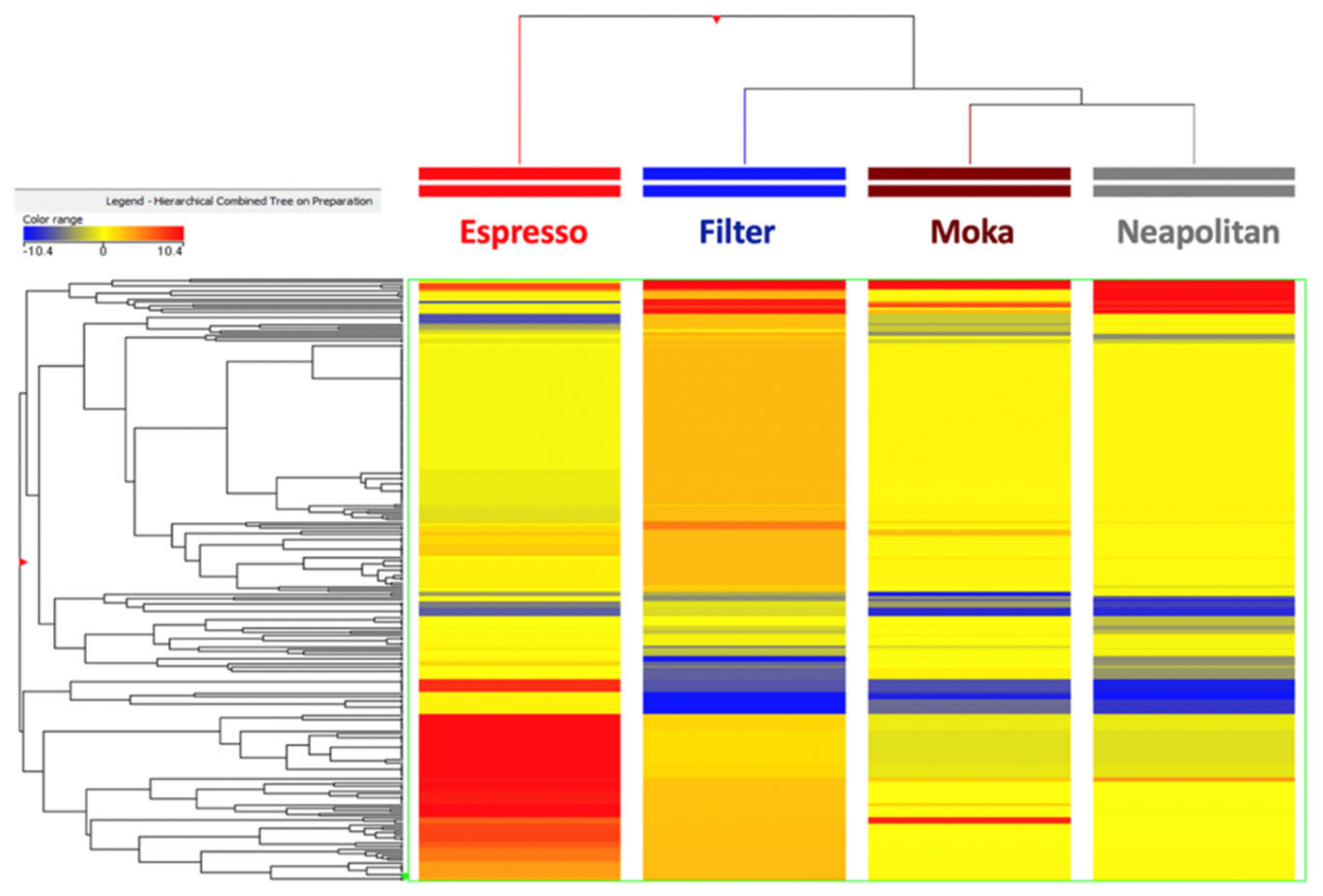
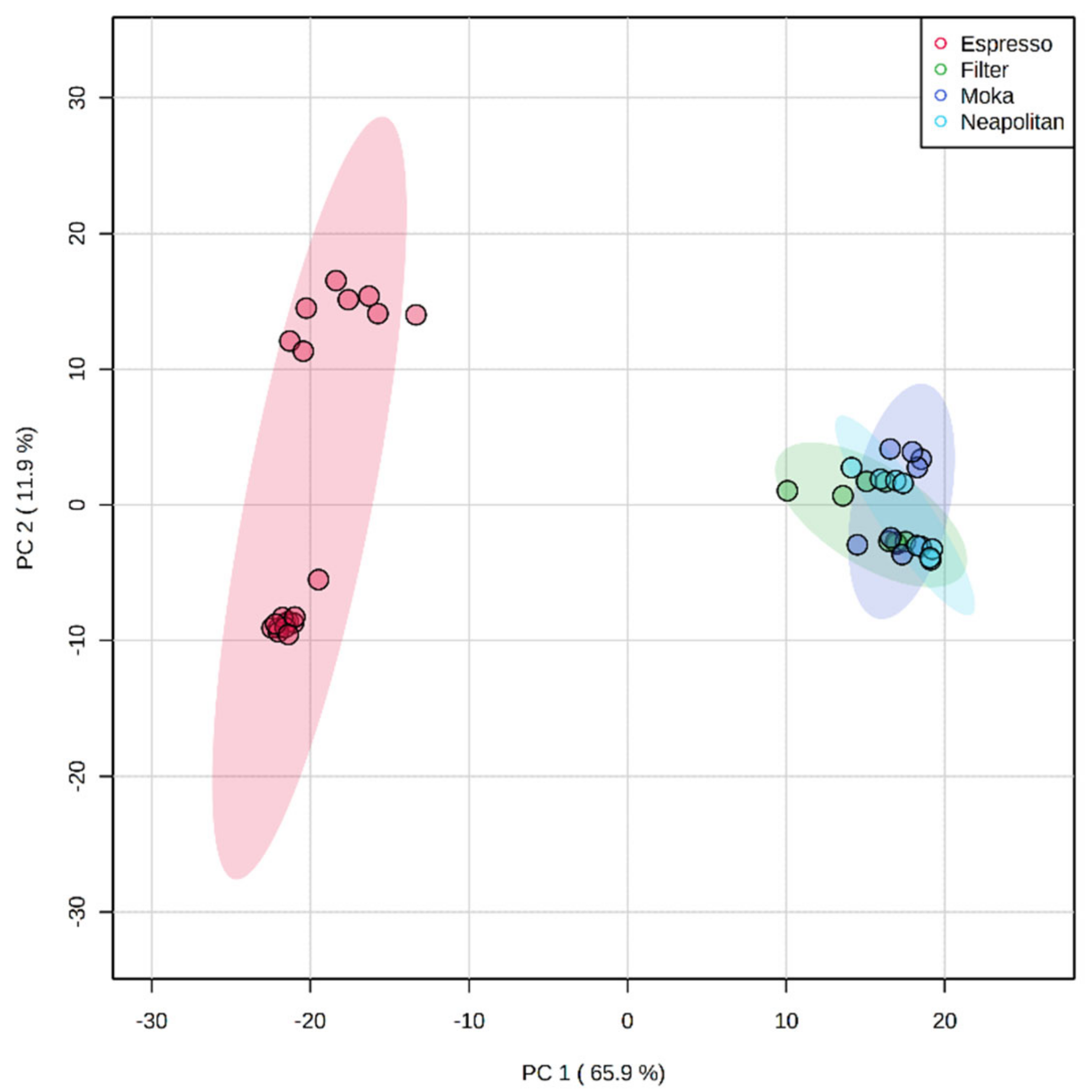
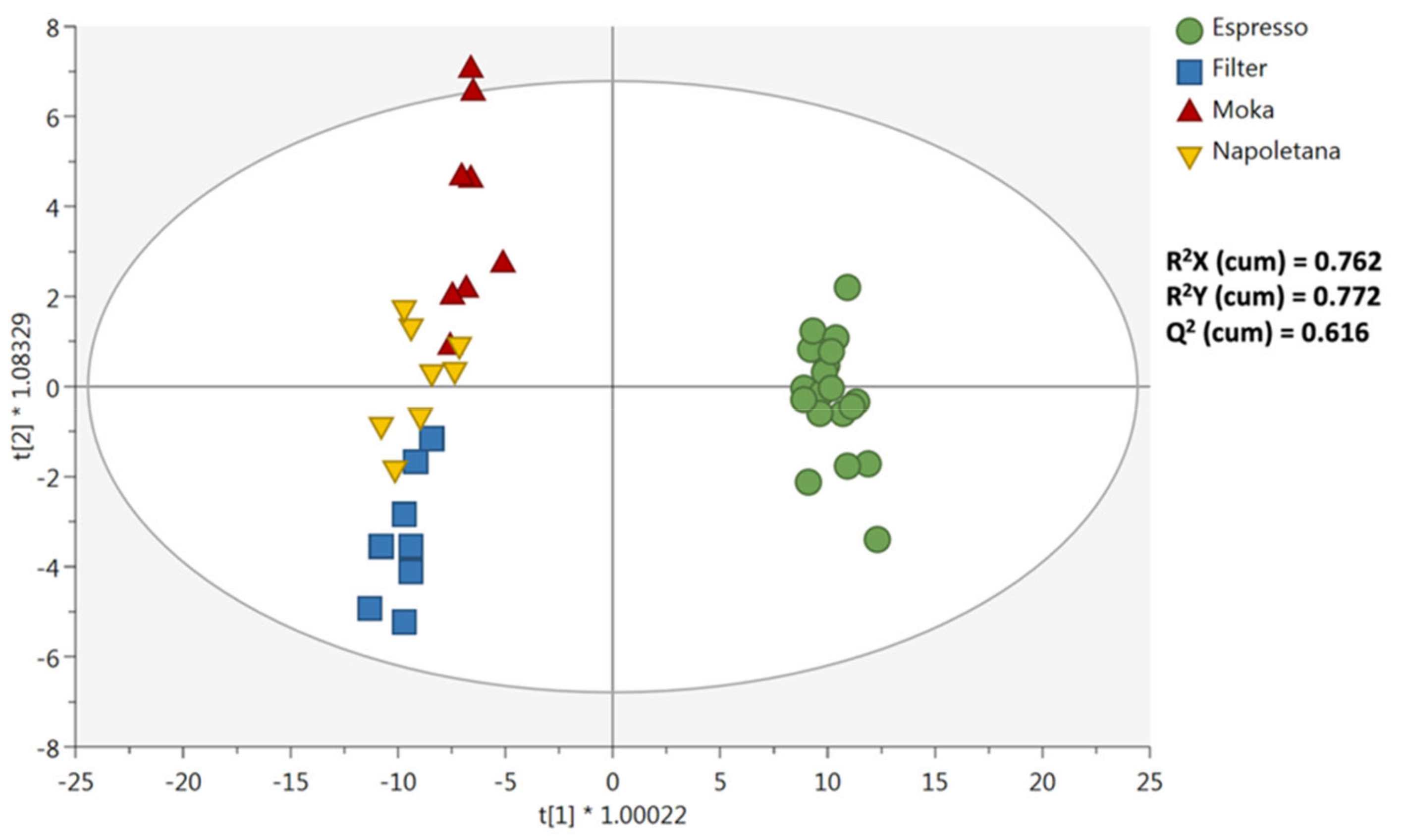
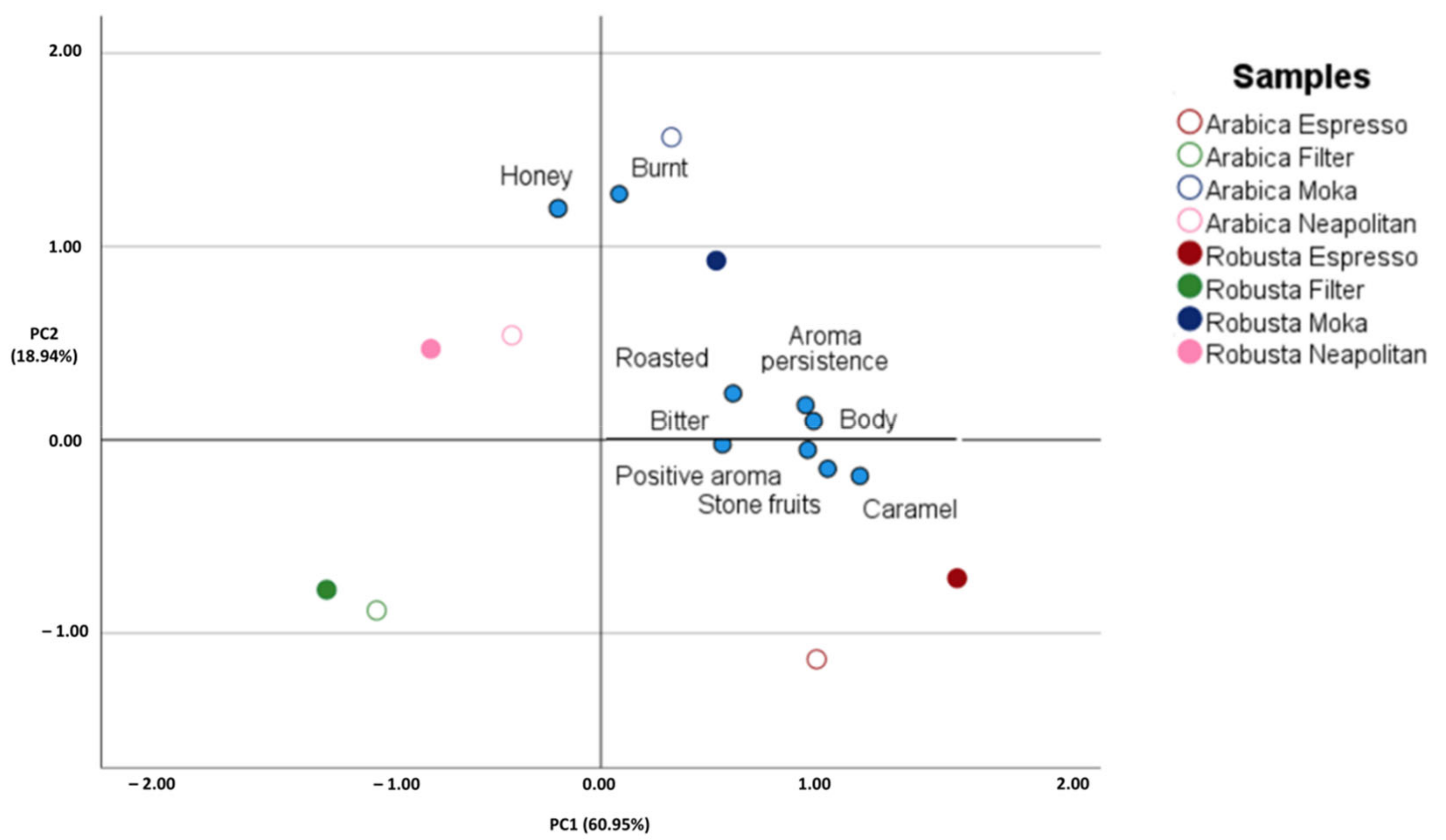
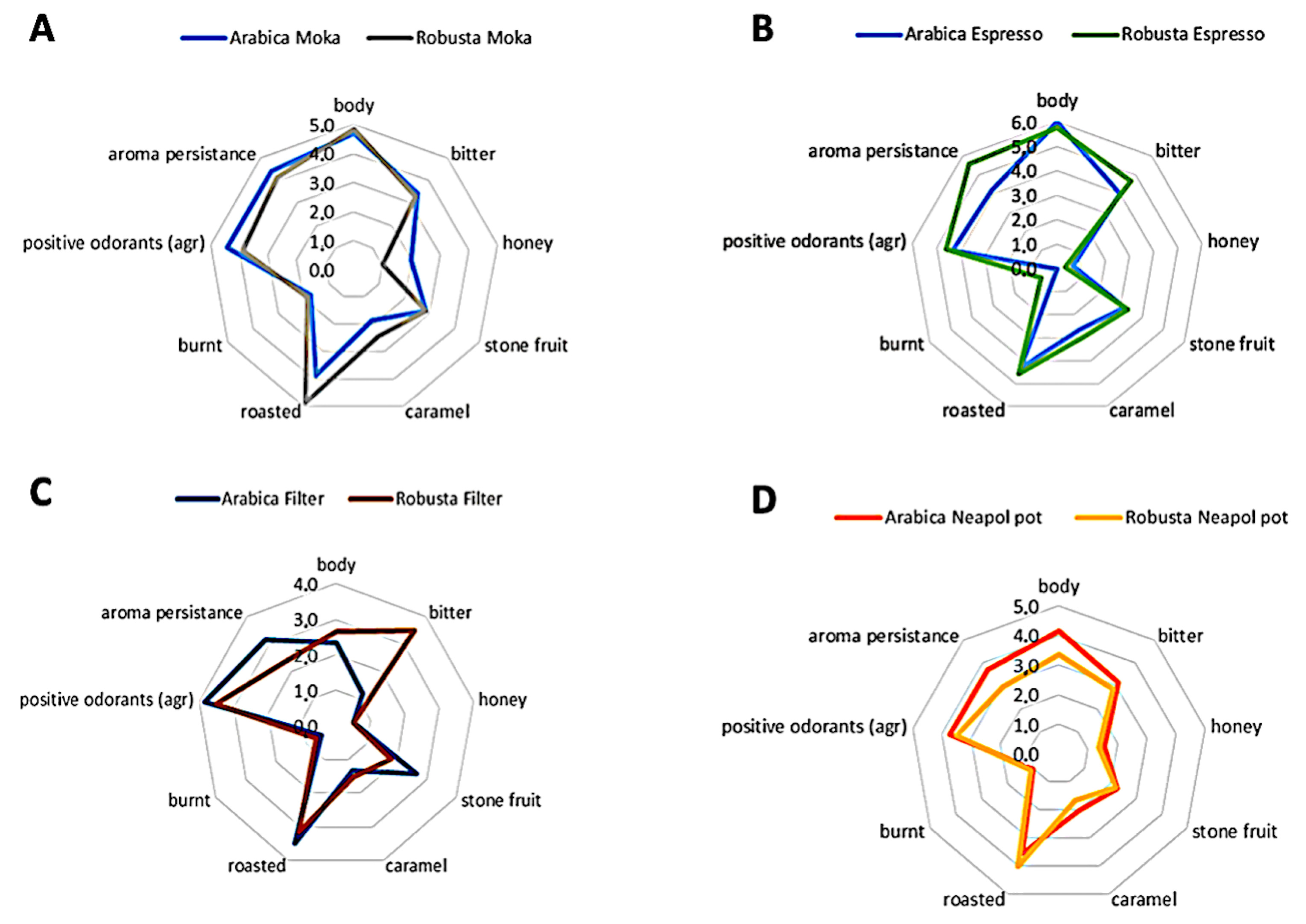
| Class | Discriminant Compounds (OPLS-DA) | VIP Score | LogFC Filter vs. Espresso | LogFC Moka vs. Espresso | LogFC Neapolitan vs. Espresso |
|---|---|---|---|---|---|
| Alkaloids | Caffeine | 1.01 | 3.44 | −0.12 | −2.48 |
| Calystegine A6 | 0.99 | 0.74 | −0.99 | −1.96 | |
| Alkyl-phenylketones | 3′,4′-dihydroxyacetophenone | 1.26 | 3.78 | 1.62 | 1.47 |
| 1-phenyl-1-propanone | 1.10 | −16.45 | −18.91 | −18.98 | |
| Amino acids, peptides, and analogues | L-homoserine | 1.07 | 1.66 | −0.25 | −0.50 |
| N-(carboxymethyl)lysine | 1.04 | −3.50 | −1.20 | −1.61 | |
| N6-formyl lysine | 1.03 | 0.27 | 0.34 | −0.03 | |
| N-(carboxyethyl)lysine | 0.91 | −13.47 | −15.97 | −15.99 | |
| N6-acetyl lysine | 0.89 | −4.13 | −6.44 | −6.65 | |
| N-caffeoyltryptophan | 0.81 | 4.74 | 2.54 | 2.34 | |
| Aryl-compounds | 1-methyl-2-carboxaldehyde pyrrole/2-acetylpyrrole | 1.37 | 3.25 | 1.29 | 1.20 |
| 1-(2-furanyl)-1-butanone | 1.37 | 0.10 | 0.53 | 0.20 | |
| 2-acetyl-6-methylpyridine/2-acetyl-5-methylpyridine | 1.09 | −0.53 | −0.22 | −0.52 | |
| 4-acetyl-3-methylpyridine/4-acetyl-2-methylpyridine | 1.09 | −0.52 | −0.21 | −0.52 | |
| Ethyl 2-furanyl diketone | 0.90 | 3.89 | 1.58 | 1.49 | |
| 1-(5-methyl-2-furanyl)-1,2-propanedione | 0.82 | 3.87 | 1.56 | 1.47 | |
| Azoles | 5-ethyl-2-methyloxazole/5-ethyl-4-methyloxazole/4-ethyl-2-methyloxazole/2-ethyl-5-methyloxazole/2-ethyl-4-methyloxazole | 1.07 | −15.21 | −17.68 | −17.73 |
| 4-ethyl-2,5-dimethyloxazole/5-methyl-2-propyloxazole/5-ethyl-2,4-dimethyloxazole | 0.97 | 0.18 | −0.01 | −0.29 | |
| 4,5-dimethyl-2-propyloxazole | 0.88 | 2.06 | −0.46 | −0.93 | |
| Flavonoids | Narirutin 4′-O-glucoside | 1.08 | −4.06 | 2.30 | −6.58 |
| Neodiosmin/Diosmin | 1.07 | 3.51 | 0.97 | 1.02 | |
| Neohesperidin/Hesperidin Quercetin 3-O-galactoside 7-O-rhamnoside/Kaempferol 3-O-sophoroside/Quercetin 3-O-rutinoside/Quercetin 3-O-rhamnosyl-galactoside/Kaempferol 3,7-O-diglucoside | 1.03 | 3.54 | 1.01 | 1.03 | |
| Pigment A/Peonidin 3-O-rutinoside/Peonidin 3-O-(6″-p-coumaroyl-glucoside) | 1.03 | 3.52 | 0.99 | 1.01 | |
| Delphinidin 3-O-rutinoside/Cyanidin 3,5-O-diglucoside/Cyanidin 3-O-sophoroside | 1.03 | 3.62 | 1.06 | 1.08 | |
| Cyanidin 3-O-glucosyl-rutinoside | 0.96 | 17.55 | 12.95 | 15.08 | |
| (+)-Catechin/(-)-Epicatechin | 0.96 | 19.18 | −1.36 | −1.36 | |
| Nepetin/Isorhamnetin/Rhamnetin | 0.91 | 4.11 | 5.53 | 5.89 | |
| Furans | Dihydroactinidiolide | 1.15 | −6.14 | −2.05 | −0.21 |
| 2,5-Dimethyl-3-(methyldithio)furan | 1.72 | 3.27 | −2.17 | −4.47 | |
| (R)-roemerine | 1.06 | −14.13 | −8.48 | −14.04 | |
| 4-[(2-Furanylmethyl)thio]-2-pentanone | 0.95 | −11.56 | −14.05 | −14.06 | |
| 2-Ethyl-4,5-dimethyloxazole | 0.94 | 0.15 | −0.03 | −0.31 | |
| Other phenolics | Tyrosol/4-ethyl-1,2-benzenediol/3-ethyl-1,2-benzenediol/4-ethylcatechol | 1.37 | 0.10 | 0.53 | 0.20 |
| 4-hydroxyphenylacetic acid | 1.17 | 3.89 | 1.74 | 1.55 | |
| Sinapaldehyde | 1.07 | −11.90 | −0.47 | −4.80 | |
| Hydroxytyrosol | 0.99 | 2.62 | 0.57 | 0.38 | |
| p-HPEA-AC | 0.99 | 2.34 | 0.24 | −4.35 | |
| threo-syringoylglycerol/erythro-syringoylglycerol | 0.86 | 2.73 | 0.48 | 0.21 | |
| Epirosmanol/Rosmanol | 0.85 | −4.83 | −7.10 | −4.08 | |
| Umbelliferone/4-hydroxycoumarin | 0.85 | 9.67 | 4.94 | 6.94 | |
| 3,4-dihydroxyphenylacetic acid | 0.83 | 0.72 | 0.45 | 0.41 | |
| p-HPEA-EA/Ligstroside-aglycone | 0.81 | 4.72 | 2.53 | 2.32 | |
| Vanillin | 0.80 | 3.87 | 1.56 | 1.47 | |
| Dimethylmatairesinol | 1.34 | 17.81 | 0.63 | 13.29 | |
| Leonuriside A | 1.07 | 2.04 | −0.28 | 2.20 | |
| Pyrazines | 2-acetyl-3,6-dimethylpyrazine/2-acetyl-3,5-dimethylpyrazine | 1.11 | −0.46 | −0.02 | −0.52 |
| Ethylpyrazine/2-ethylpyrazine/2,5-dimethylpyrazine/2,6-dimethylpyrazine/dimethylpyrazine/2,3-dimethylpyrazine | 1.08 | −15.30 | −17.61 | −17.96 | |
| 2-isopropyl-6-methoxypyrazine/2-isopropyl-5-methoxypyrazine | 1.01 | −5.01 | −0.38 | −0.76 | |
| 2-methyl-3-(2-methylpropyl)pyrazine | 0.85 | −2.83 | −5.32 | −5.35 | |
| 2,5-diethyl-3-methylpyrazine | 0.84 | −2.76 | −5.26 | −5.29 | |
| 2,3-diethyl-5-methylpyrazine | 0.84 | −2.81 | −5.31 | −5.33 | |
| 3,5-diethyl-2-methylpyrazine | 0.83 | −2.79 | −5.29 | −5.31 | |
| Pyridines | 6-acetyl-2,3,4,5-tetrahydropyridine | 0.98 | 0.20 | −0.06 | −0.29 |
| 3-ethyl-pyridine | 0.89 | 0.35 | 0.12 | −0.15 | |
| 2-ethyl-5-methylpyridine | 0.88 | 2.08 | −0.45 | −0.92 | |
| Pyrroles | N-furfurylpyrrole/1-furfurylpyrrole | 0.89 | −14.44 | −16.93 | −16.96 |
| 1-(2-furanylmethyl)-1H-pyrrole | 0.82 | −14.45 | −16.93 | −16.97 | |
| 2-acetyl-1-pyrroline | 1.07 | −15.21 | −17.68 | −17.73 | |
| Stilbenes | Pinosylvin | 1.15 | 7.24 | 0.94 | 4.90 |
| 4-vinylsyringol | 1.10 | −14.94 | −17.44 | −17.46 | |
| Pterostilbene | 0.94 | −14.20 | −16.69 | −16.72 | |
| Phenolic acids | 1,2-disinapoylgentiobiose | 1.48 | 9.30 | 0.63 | 9.01 |
| Gallic aldehyde/2,4-dihydroxybenzoic acid/Protocatechuic acid/3,5-dihydroxybenzoic acid/2,6-dihydroxybenzoic acid/2,3-dihydroxybenzoic acid/Gentisic acid | 1.11 | −14.46 | −16.95 | −16.98 | |
| 5-caffeoylquinic acid/3-caffeoylquinic acid/Cryptochlorogenic acid/4-caffeoylquinic acid/1-O-caffeoylquinic acid/trans-neochlorogenic acid | 1.07 | −8.44 | −0.33 | −8.44 | |
| p-coumaric acid ethyl ester | 1.07 | −4.10 | 2.16 | −6.62 | |
| 1-sinapoyl-2-feruloylgentiobiose | 1.07 | −4.06 | 2.30 | −6.59 | |
| Caffeic acid ethyl ester | 1.07 | −11.90 | −0.47 | −4.80 | |
| p-coumaroyl tartaric acid | 0.95 | −8.69 | −11.19 | −11.21 | |
| m-coumaric acid/o-coumaric acid | 0.90 | −15.13 | −17.44 | −17.65 | |
| Caffeic acid/trans-caffeic acid | 0.85 | 9.67 | 4.94 | 6.94 | |
| Vanillic acid | 0.83 | 0.72 | 0.45 | 0.41 | |
| 4,5-dicaffeoylquinic acid/3,4-dicaffeoylquinic acid/3,5-di-O-caffeoylquinic acid/3,5-dicaffeoylquinic acid/4,5-di-O-caffeoylquinic acid | 0.80 | 0.67 | −1.83 | −1.85 | |
| Other compounds | Floribundine | 1.07 | −13.84 | −16.34 | −16.37 |
| 2-methylbenzaldehyde/4-methylbenzaldehyde/3-methylbenzaldehyde/phenylacetaldehyde/4-vinylphenol | 1.05 | −14.37 | −6.53 | −8.65 | |
| 3,5-dimethyl-1,2-cyclopentanedione/3-ethyl-1,2-cyclopentanedione/3,4-dimethyl-1,2-cyclopentanedione/3-methyl-1,2-cyclohexanedione | 1.10 | −13.81 | −15.96 | −17.06 | |
| Damascenone | 0.92 | −2.38 | −0.05 | −0.32 | |
| (R)-2-hydroxy-4,7-dimethoxy-2H-1,4-benzoxazin-3(4H)-one 2-glucoside | 0.90 | 2.90 | 0.29 | 0.15 | |
| Rubrofusarin 6-[glucosyl-(1-3)-glucosyl-(1-6)-glucoside] | 0.96 | 16.79 | 12.16 | 16.38 | |
| b-D-glucuronopyranosyl-(1-3)-a-D-galacturonopyranosyl-(1-2)-L-rhamnose | 0.80 | 0.67 | −1.83 | −1.85 | |
| 5-methylquinoxaline | 1.09 | −14.22 | −16.72 | −16.74 | |
| O-methylcorypalline | 1.06 | 2.30 | −0.05 | −0.34 | |
| 3-mercapto-3-methyl-1-butanol/4-(methylthio)-1-butanol | 1.04 | −14.31 | −6.46 | −8.59 |
| Sensory Descriptors | Arabica Moka | Arabica Neapolitan Pot | Robusta Moka | Robusta Neapolitan Pot | Arabica Espresso | Robusta Espresso | Arabica Filter | Robusta Filter |
|---|---|---|---|---|---|---|---|---|
| Color intensity | 7.0 | 6.7 | 6.9 | 6.1 | 7.0 | 7.3 | 7.0 | 7.2 |
| Aroma intensity | 5.4 | 4.1 | 5.6 | 4.0 | 6.7 | 6.2 | 4.8 | 5.2 |
| Body | 4.7 | 4.1 | 4.9 | 3.4 | 6.0 | 5.8 | 2.3 | 2.7 |
| Acidity | 3.1 | 1.4 | 1.9 | 2.1 | 3.8 | 3.3 | 1.8 | 2.2 |
| Bitter | 3.4 | 3.1 | 3.3 | 2.9 | 4.0 | 4.7 | 1.2 | 3.5 |
| Astringency | 2.1 | 2.3 | 1.7 | 1.4 | 2.0 | 2.8 | 1.0 | 1.3 |
| Honey | 2.0 | 1.6 | 1.0 | 1.4 | 0.7 | 0.3 | 0.5 | 0.5 |
| Floral and fruity | 2.0 | 1.3 | 1.3 | 1.6 | 1.3 | 0.7 | 1.5 | 1.0 |
| Dry vegetal | 2.3 | 2.7 | 3.9 | 2.4 | 2.2 | 3.8 | 2.0 | 1.8 |
| Vegetal | 2.7 | 3.1 | 3.9 | 2.9 | 2.3 | 3.1 | 2.0 | 1.7 |
| Stone fruit | 2.9 | 2.3 | 2.9 | 2.2 | 3.2 | 3.3 | 2.7 | 1.8 |
| Nuts and dry fruits | 3.9 | 3.3 | 4.0 | 3.1 | 2.7 | 3.3 | 2.8 | 2.2 |
| Cereals | 2.9 | 2.6 | 3.9 | 3.1 | 3.5 | 3.4 | 3.7 | 2.5 |
| Caramel | 1.9 | 2.0 | 2.4 | 1.6 | 2.7 | 3.0 | 1.3 | 1.5 |
| Cocoa | 2.3 | 2.4 | 2.3 | 2.4 | 1.5 | 2.7 | 0.7 | 1.2 |
| Pastry | 2.6 | 2.0 | 1.0 | 1.8 | 2.5 | 1.6 | 1.5 | 1.0 |
| Roasted | 3.9 | 3.6 | 4.9 | 4.0 | 4.3 | 4.6 | 3.5 | 3.2 |
| Burnt | 1.7 | 1.0 | 1.9 | 1.1 | 0.0 | 0.8 | 0.5 | 0.7 |
| Positive aromas | 4.4 | 3.7 | 3.9 | 3.5 | 4.3 | 4.6 | 3.8 | 3.5 |
| Aroma persistence | 4.4 | 3.7 | 4.1 | 2.9 | 4.2 | 5.6 | 3.2 | 2.3 |
Publisher’s Note: MDPI stays neutral with regard to jurisdictional claims in published maps and institutional affiliations. |
© 2022 by the authors. Licensee MDPI, Basel, Switzerland. This article is an open access article distributed under the terms and conditions of the Creative Commons Attribution (CC BY) license (https://creativecommons.org/licenses/by/4.0/).
Share and Cite
Vezzulli, F.; Rocchetti, G.; Lambri, M.; Lucini, L. Metabolomics Combined with Sensory Analysis Reveals the Impact of Different Extraction Methods on Coffee Beverages from Coffea arabica and Coffea canephora var. Robusta. Foods 2022, 11, 807. https://doi.org/10.3390/foods11060807
Vezzulli F, Rocchetti G, Lambri M, Lucini L. Metabolomics Combined with Sensory Analysis Reveals the Impact of Different Extraction Methods on Coffee Beverages from Coffea arabica and Coffea canephora var. Robusta. Foods. 2022; 11(6):807. https://doi.org/10.3390/foods11060807
Chicago/Turabian StyleVezzulli, Fosca, Gabriele Rocchetti, Milena Lambri, and Luigi Lucini. 2022. "Metabolomics Combined with Sensory Analysis Reveals the Impact of Different Extraction Methods on Coffee Beverages from Coffea arabica and Coffea canephora var. Robusta" Foods 11, no. 6: 807. https://doi.org/10.3390/foods11060807
APA StyleVezzulli, F., Rocchetti, G., Lambri, M., & Lucini, L. (2022). Metabolomics Combined with Sensory Analysis Reveals the Impact of Different Extraction Methods on Coffee Beverages from Coffea arabica and Coffea canephora var. Robusta. Foods, 11(6), 807. https://doi.org/10.3390/foods11060807









